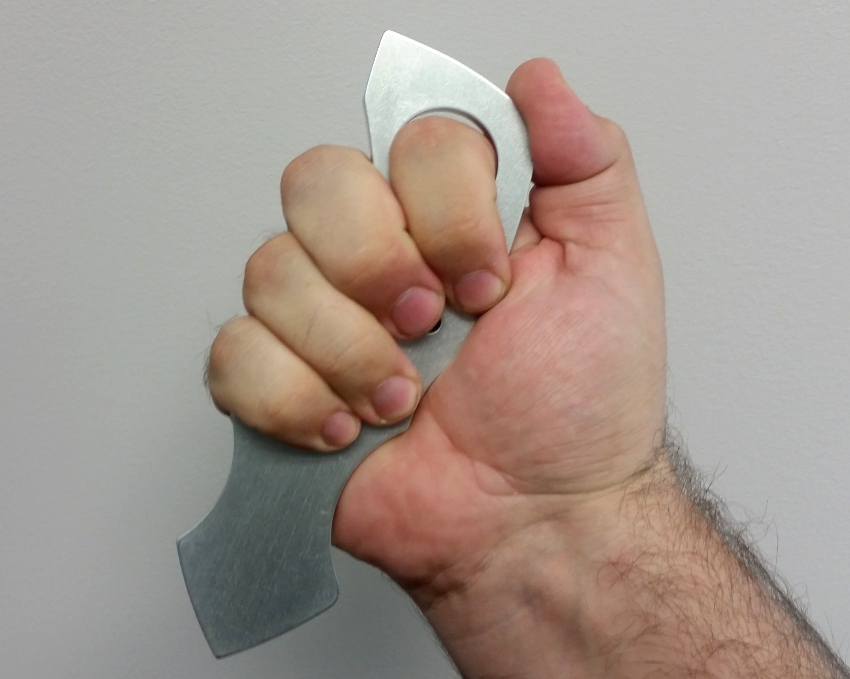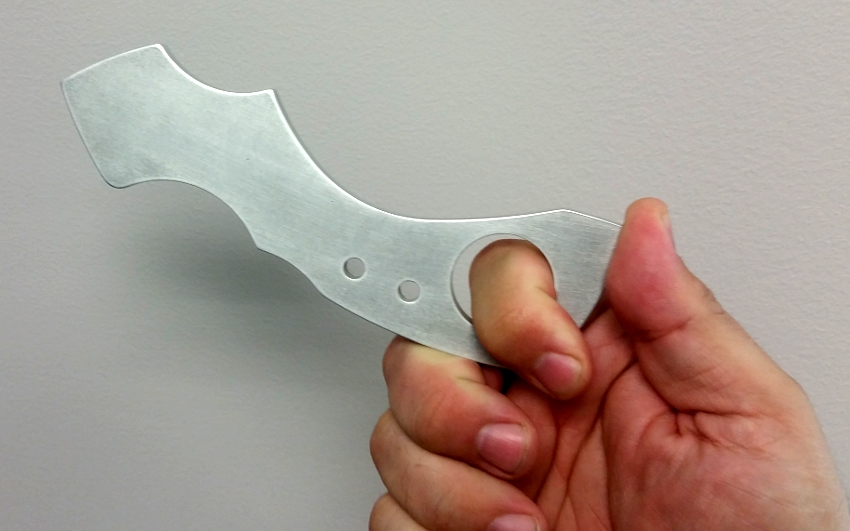Some time ago now, New Zealander Emanuel Roth of ROTH Tactics and Solutions sent me this ingenious little piece of aluminum he calls the E-Ring, a collaboration between Roth and famed knifemaker Laci Szabo. This is nothing more or less than an impact tool machined from aluminum that has a finger ring (and some drilled out holes to improve balance, to which a lanyard could also be affixed). It has the benefit of being relatively unobtrusive because it’s a different form factor than most other impact tools on the market. The irony, however, is that the better known such a tool becomes (and thus the more people have it), the more visible and recognizable it is as a weapon. Still, its unconventional appearance may make it less of a daily carry liability than a more familiar impact tool like a kubotan, and it is definitely less obvious than a pair of brass knuckles or a kerambit. It incorporates aspects of all three tools in both function and form.
“It’s actually extremely simple, despite its looks,” Roth told The Martialist, “and fully takes into account natural human physiology, namely, the effects of an adrenaline dump during an attack.”
In other words, when the adrenaline of a close-quarters encounter, a real-life self-defense scenario, turns you into a lobster-clawed imbecile locked on fight-or-flight mode, you can still grasp the tool and strike or punch with it. Roth explains, “Obviously, in a high intensity/high stress situation, everyone will just about always be left with only gross motor skills. Anything I design will always take this into account beyond anything else. Keeping this in mind, the two simplest gross motor arm movements are an up/down icepick movement and a simple in/out punching movement. My tool is designed with exactly these two simple movements in mind… You can punch with it, and you can icepick with it, and it is held in the hand very securely with the finger ring (similar to a kerambit). Think of it as a kubaton and knuckleduster in one.”
The E-Ring is machined entirely in the United States from aircraft-grade aluminum. It is 1/4-inch thick and just under 7 inches long. The diameter of the finger hole is about 1.1 inches. Overall, the tool is heavy enough to be substantial but not heavy enough to be a burden when carried. It is nicely machined; everything is rounded to prevent sharp edges that could scrape or even cut you, but the “pointy” knobs would make for very devastating strikes. There are ergonomic contours that are probably slightly better tailored for someone whose hands are not as fat as mine (I have very large mitts), but I did not find holding or using the E-Ring to be uncomfortable. You can of course spin it by the index finger to reposition it, and you could extend it in that grip (it is contoured to let you stop it right where you want it). I’m not sure what I would use that extended grip to do; possibly a longer-range poke or whip-like motion would be appropriate.
Notable is the protrusion forward of the finger ring, which makes forward punching with the E-Ring a very viable option. It’s possible that in some muncipalities, this could make the tool equivalent to brass knuckles in the eyes of the law, but I’m not sure how consistently one could expect that to be enforced. I’ve heard horror stories of multiple-finger jewelry (popular with urban thugs a few years back) being interpreted as brass knuckles, so you never know. The idea wouldn’t dissuade me from carrying the E-Ring, though.
“A trained martial artist will clearly be able to think of more ways to employ the E-Ring, should the situation make it possible, not least of all to encompass trapping and locking techniques. Other, even more advanced techniques can be employed with the tool, for example an extended grip as a Filipino Martial Artist would do with a kerambit. The point by the finger hole is perfectly placed to assist with stopping the tool in exactly the right moment.” Roth adds.
I think for extended day to day carry I would definitely attach a lanyard, which would facilitate both drawing the tool from a pocket and also help make the carry position more consistent (assuming the lanyard was lightly weighted and draped outside the pocket, as you would do with some small knives). I’m very tempted to add it to my daily rotation simply because it is so unusual. It’s a simple, effective tool that does precisely what Roth says it does, yet doesn’t look like something provocative just sitting on a desk. It’s also reasonably intuitive if you have any experience with blunt or edged self-defense tools.
You can check out Emanuel Roth’s site at http://roth.yolasite.com/. As of this writing, the E-Ring is available from Unique Tactical Tools.



